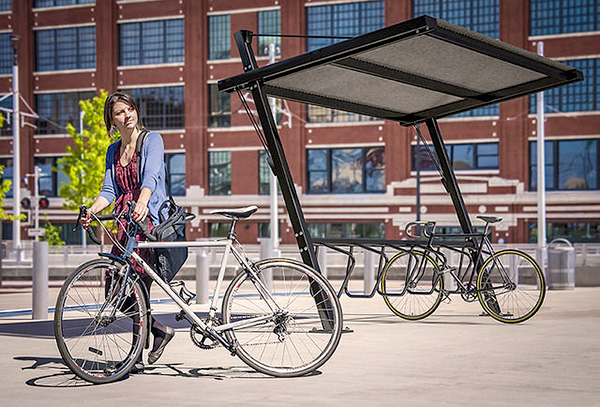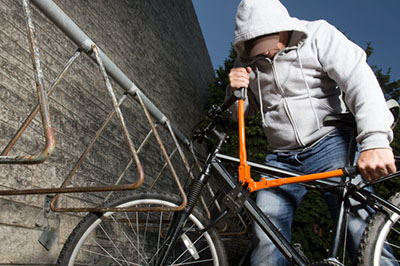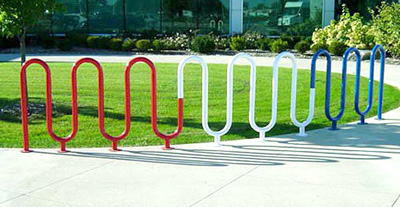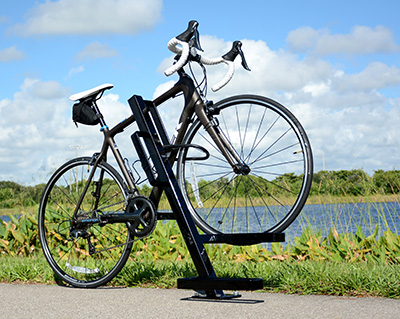 Commercial bike racks are becoming a more important part of the landscape as the number of bike commuters has increased 46% nationwide from 2005 to 2013 and more than 100% in several major cities
Commercial bike racks are becoming a more important part of the landscape as the number of bike commuters has increased 46% nationwide from 2005 to 2013 and more than 100% in several major cities
Commercial bike racks vary in shape and size but are basically designed for two types of classes - long-term and short-term parking. Both of those classes involve bicycle security.
It's important to know how your location applies to those bicycle parking classifications.
But here's probably the most important factor to consider - bike thefts.
Bicycle thefts are on the rise across the country. The FBI says more than 200,000 bike thefts were reported in 2014.
That's reported thefts. Experts say there are a huge number of unreported thefts. The real number is probably more than 1 million bicycles stolen every year.
Street crime has increased in most major American cities, especially with the opioid crisis. Combine this with the fact that people now buy more expensive bicycles, many in the $300 to $500 range, with some costing more than $1,000. In cities such as Montreal, a survey found more than 50% of active riders have had their bicycle stolen.
Police are certainly aware of this trend. But they obviously are forced to focus on more serious crimes. For example, a study in Portland, one of the most active bicycle communities in the US, found that arrests for bike thefts only took place in about 2% of cases.
Bicycle thieves have become very adept at this type of crime. They can recognize the more lucrative targets. Many carry cable cutters and hacksaws while on the watch for quick steal opportunities. Others use more sophisticated tools such as commercial bolt cutters or hydraulic bottle jacks.
 Bike thefts are on the rise which is why commercial bike racks need to be secure and in highly-visible location
Bike thefts are on the rise which is why commercial bike racks need to be secure and in highly-visible location
There are even some professional criminals who walk around with portable battery-powered angle grinders that can virtually cut through anything, even a steel safe given enough time.
Cable locks and locks with cheap padlocks are virtually useless today. Hardened metal U-locks are considered the most reliable.
But even the toughest lock can be cut. For example, one of the best locks on the market is the Kryptonite Fahgettaboutdit Mini. This lock deters most thieves. It should. It's weighs 4.5 pounds and is composed of three layers of heat-hardened metal. It's basically the beast of bike locks.
But if a crook has a grinder, it is estimated they can cut through this metal monster in 10 minutes. (Of course, you would have to be pretty dumb to stand on a sidewalk grinding away at this lock for several minutes while sparks fly in all directions.)
The bottom line - no lock is totally tamper-proof.
That's why it's critical to keep bicycle security in mind when ordering and installing bike racks.
Commercial bike racks - Class II parking
Let's start with Class II bicycle parking - the more common practice of short-term parking.
Short-term bicycle parking generally means a time frame of two to perhaps six hours. These are the type of commercial bike racks typically installed at schools, stores, office buildings, parks - any place where a person is not expected to spend longer than eight hours or overnight.
There are a few important factors for these bike racks - convenience, visibility and security.
Your goal is to make these outdoor bike racks easily accessible and located close to their destination. The Association of Pedestrian and Bicycle Professionals recommends installing these bicycle racks no more than 50 feet from an entrance way.
If you don't locate these commercial bike racks nearby, a few things can happen. For one, cyclists will lock their bike to something closer to the entrance - either a tree, hand rail, sign, whatever. That's not a good idea. For one, these bikes will be an impediment for pedestrians. Secondly, there is a higher likelihood of theft.
Thieves have been known to cut down a tree to grab a bike.
Some thieves will create what they call "sucker poles" where they loosen a street sign in the ground. Then when an unsuspecting bicyclist locks their bike to the signpost, the crooks just pull the sign out of the ground and rip off the bike.
Then there are city maintenance workers who may also come by with a bolt cutter and take away bicycles attached to public property or trees. Not only will the bike be impounded, but there will probably be a hefty fee to get it back.
As we said, even if you provide bike racks near a building, make sure they are not hidden away in an alley or some out of the way place. Keep them visible. In front of windows, so employees, students or store patrons can keep an eye on them.
A sheltered area to keep the rain and snow off the bicycles would be nice too. There are bike shelters with roofs available that are becoming more popular with planners and architects.
If you want to make your destination bicycle-friendly, a coffee shop for example, then along with commercial bike racks add a covered bike shelter. If you want to make your destination even more of a hot spot, offer a bike repair station with a manual air pump and handy tools. That will get the attention of bicyclists.
Types of Class II commercial bike racks
Here are some of the commercial bike racks used in the short-term parking, Class II category:
Grid bike racks - these are perfect for quick parking. They are the old-fashioned type of bike racks that have the comb-like appearance. Generally, the cyclist can only lock the front wheel and most use a cable bike lock. These types of racks are usually just for very short-term and temporary parking.
Conversely, many bike valet stations for major events will utilize portable grid racks. This type of commercial bike rack is popular at events because they are portable, can accommodate a large number of bicycles and are easily placed in an enclosed fence under the watchful eye of security.
A bike valet service is a great way to encourage people to ride their bikes to events rather than drive and contribute to those frustrating traffic jams that occur when an event ends.
U-racks or "Staple" bike racks - these have thicker steel tubing than grid racks and look like an inverted U mounted into the ground, preferably a concrete slab.
These bike racks are for basically two bikes, one on either side. They are designed to hold the bikes upright if locked properly. With U-racks you have modular capabilities and can add a bunch of these commercial bike racks at different points around a landscape.
Wave bike racks- these heavy-duty bike racks are popular right now and have a cool aesthetic appearance. They are also made with heavier steel tubing and can hold several bikes. Plus, those bikes can be locked to the frame with a U-lock. However, it's critical that users lock their bikes upright and secure. Otherwise, the bikes will fall and create a haphazard situation.
Bollard bike racks - this type of bike rack, basically a pole with a circle welded near the top, can serve two purposes. One is for bicycle parking. The second is as an actual bollard itself to protect sidewalks from cars. Some cities will combine their parking meters with a bollard bike rack.
By the way, with U-racks and Wave racks, there is a new trend now to use "square" tubing instead of round tubing. These square tube bike racks make it difficult to cut with traditional pipe cutters.
There is also a growing trend to create another class of commercial bike racks - racks that can provide three points of locking contact as recommended by the APBP. That would be locking the frame and the front wheel (to prevent wheel thefts) as the best scenario to prevent theft and keep bikes upright. Experts at Kryptonite bike locks recommend locking the frame and back wheel with a U-lock. Keep the lock tight so a tool can't be inserted in between. Then use a second cable lock to lock the front wheel to the bike rack or use a second U-lock to lock the front wheel to the bike frame.
New wave of outdoor bike rack designs
Bicycle parking experts on the staff of The Park and Facilities Catalog have invented a unique bicycle parking rack called the "Uplift." This commercial bike rack, made of sturdy steel tubing, has a wheel well where the front or rear tire is inserted. Then there are locking arms positioned at the top of the tube. This provides the three points of locking contact which is designed for those sturdier U-locks.
This configuration keeps a bike standing upright so the bike and rack take up a smaller footprint. Therefore, more bicycles can be added per square foot.
This type of bike rack also has high-density modular advantages as they can be distributed around a location to maximize the space for bicycle parking. It's a great solution for facilities, such as universities or train stations, where a large number of bicycles need to be parked.
One note. Lately, the invention of "dockless" bicycles have become the rage in many cities. These are bike share bicycles that have built-in locks. The locks are unlocked using Bluetooth technology. In essence, they can be parked anywhere. The rider just gets off the bicycle and leaves it wherever they want.
In theory, this might sound like a great idea. However, many cities are encountering problems where these bicycles are left scattered at popular locations such as event venues plus train or subway stations for example. This creates a hazardous situation for pedestrians. They also contribute to congestion because people have to navigate their way around these bicycles. As for security, while the bicycle may be locked, it can still be picked up and loaded onto a truck for dismantling later.
Class I long-term bicycle parking solutions
Class I or long-term bicycle parking has different requirements.
In this particular category, bicycles are meant to be stored at a location for a long period of time. Convenience is not as much of a factor as security. In many instances, these bicycles will be locked in a secure bike room. Or, they may be stored in an enclosed bicycle locker.
Vertical bike racks - these types of commercial bike racks are popular in bike rooms and also parking garages because they can store a large number of bicycles in a limited space.
Vertical bike racks can be wall-mounted or freestanding. Generally, the bicycles are placed in the racks upright. However, it's important that those bike racks also come equipped with locking arms so the bicycle has three points of locking contact.
Double-decker bike racks - these indoor bicycle parking racks can double the number of bikes in an area. The key consideration for double-decker bike racks is the ease in which a person can load their bicycle into the rack. Some of these commercial bike racks have "lift-assist" trays that lower to make it easier to load up a bicycle.
Bike lockers - these are growing in popularity as they offer the ultimate in bicycle storage. Basically, they are a secure box with a lock. Some cities and apartment buildings have found these bike lockers to be a source of additional revenue as a fee can be charged for more protected bicycle parking.
Added security - for long-term parking, it's also a good idea to provide surveillance cameras or secure doorways that can only be accessed with a key or code.
Bike rooms are a very hot trend right now as a solution for long-term parking needs. Some cities actually require large apartments and office buildings to include secure bike rooms for cyclists.
As more and more cities invest millions in protected bike lanes and encourage people to pedal than drive, more bike rooms will be built in the future.
Some savvy developers are even promoting their bike rooms as amenities to attract renters and condo buyers.
One final suggestion. A simple sign can also create a more secure environment for bicycles. Install signage outside warning bike thieves that these outdoor bike racks are under surveillance. Also, use signage to instruct people on the best way to lock a bicycle with a hardened U-lock or heavy chain.
In England, one large sign posted outside a bike parking area featured a pair of eyes warning bike thieves they were being watched. This simple strategy resulted in a huge decline in bike thefts in that location.
That's the difference between short-term and long-term bicycle parking and the different classes of bike racks.
Here's the 10,000-foot overview. Bicycle purchases are on the rise. Bicycle commuting is booming. According to the League of American Bicyclists, states have seen on average a 46% increase in bike commuters. Cities that invested in bicycle infrastructure have seen a 105% increase in bike commuters from 2005-2013.
This old-fashioned mode of transportation is taking on a new life. It's certainly less expensive to build one mile of a protected bike lane than one mile of new roads or rail lines.
That's great news for cities as a solution to reduce traffic congestion, clean up the air and help citizens stay healthy.
But there's also this reality. As the number of cyclists increases, more commercial bike racks manufactured for specific environments and usage will be needed to accommodate this enormous surge in the number of bicycles.




